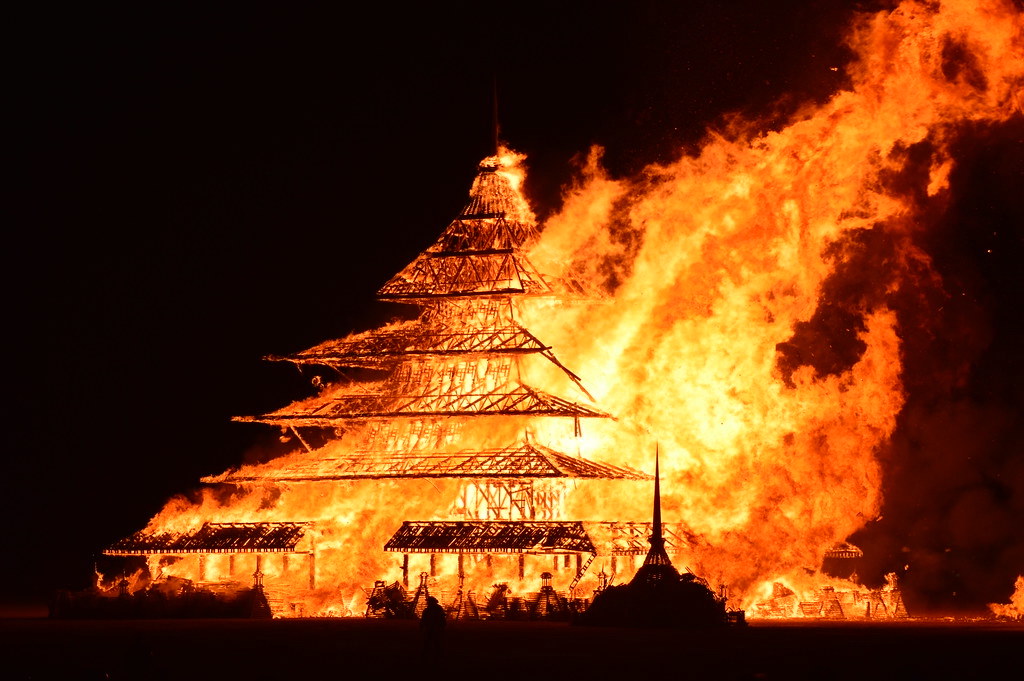Burning Man, a festival that claims on their website to center around radical sustainability, is burning our planet. In 2019, the entire country of The Gambia, with a population of over 2,300,000 people, produced 250,000 tons of Carbon Dioxide (CO2). In the same year, with an attendance of only 78,000, Burning Man emitted 100,000 tons in just nine days.
The festival began in 1986 when two men decided to burn a giant wooden sculpture of a man on Baker Beach. This soon became a yearly tradition with artists, woodworkers, metalworkers and various creatives bringing their own creations out to the beach – and eventually to the Nevada desert once the population increased – to burn the giant man. “The creativity and inspiration and openness, freedom and connectedness the place inspires is special. It is unique,” said Cara Daniels, a Burning Man attendee and Urban parent.
However, in the past decade, some say the culture has shifted rapidly to one of hypocrisy, wealth and consumerism – one which has enabled reckless consumption and emissions. “It should be a really cool place [where] artists can come and create things, but in execution, it’s just a capitalist d—k-swinging contest … ‘Who can create the thing with the most LED lights?’” said Clementine Nelson ‘24.
According to the Black Rock City Census, 42% of Burning Man’s attendees make between $100,000 and $299,999 a year, with another 15% making $300,000 or more. “It just becomes this lavish experience of wealth, in an environment where people already shouldn’t be,” said Nelson. “The original spirit was so beautiful … but those people are gone.”
The wealth of these attendees often manifests in incredible amounts of waste. Over 2,000 private aircraft landed at Burning Man in 2023 alone, making the jets one of the largest contributors to CO2 emissions at the festival. The average private jet generates more CO2 in two hours than most cars emit in an entire year of use, according to the Environmental Protection Agency (EPA).
“The emissions from [private and charter jets] dwarf those from other forms of transport,” said Natural Resources Teacher Geoff Ruth. “I also think that how many people fly there is pretty counter to the ethics and ethos of Burning Man.”
According to the 2022 Black Rock City Census, over 90% of attendees consider the principle of Leave No Trace to be important to them.
“80,000 people camp together in a desert for two weeks and two months later, there is so little [trash] left that it fits in a couple of gallon-sized zip lock bags,” said Daniels.
However, the trash that attendees pick up from the festival grounds is often illegally dumped in surrounding cities, overflowing dumpsters with everything from human waste to entire buildings, tents and art pieces. Residents of Reno, Truckee and South Lake Tahoe have long complained about the incredible amounts of waste and trash illegally left in their communities after the festival.
In an interview with the San Francisco Chronicle, Pershing County Sheriff Jerry Allen said, “[there were] large amounts of property and trash strewn from the Festival into Reno and points beyond.”
The actual burning of the man is also incredibly wasteful. This year, the wooden man reached the highest ever (a whopping 79 feet), and a separate, full-sized, 80-foot-tall temple was also built solely to be burned.
This act is both wasteful and ignorant, especially for a festival where nearly 40% of the participants come from wildfire-ravaged California.
“The whole act of burning the man is a lot of smoke to be putting into the environment,” said Nelson. “In my neighborhood, people have had the police called on them for having a wood fire in their backyard because of all of the protective laws and the fact that we let a bunch of rich tech dudes get away with it is ridiculous.”
The organizers of Burning Man have set goals to have net-zero carbon emissions by 2030, planning to use large amounts of solar power and ecologically conscious building processes.
“I do think it’s good that Burning Man organizers have a sustainability ethos to reduce the impact… even if [the damage is] still going to be considerable,” said Ruth.
However, Burning Man still has a long way to go to reach its claimed ethos of radical sustainability. Until the organizers can separate themselves from the whims of billionaire attendees, remove the private airport, prevent participants from dumping trash in cities near the playa, and replace gas-powered A/C units, Burning Man will continue to be a beacon of environmental hypocrisy for the wealthy and privileged in the United States.


